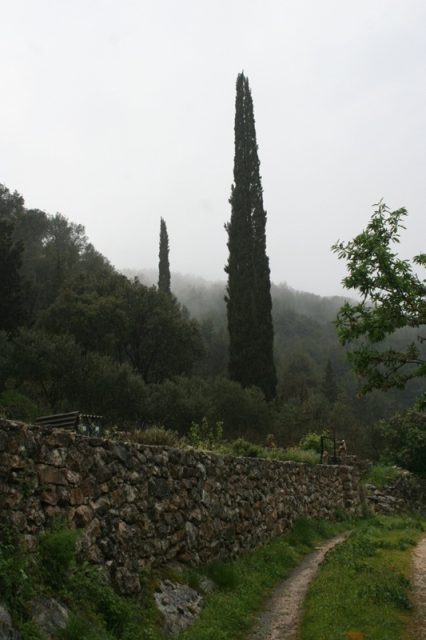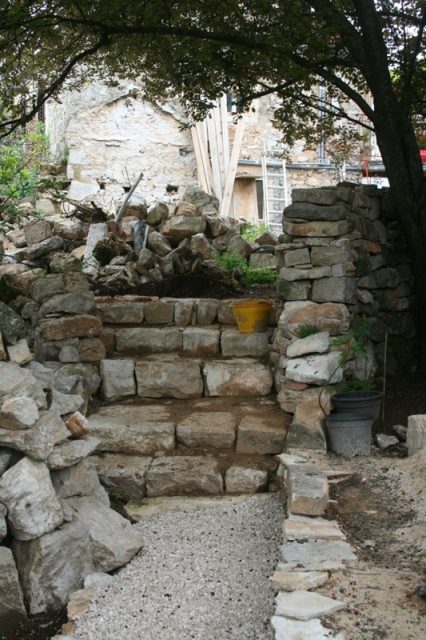Be careful what you wish for!

This week: Be careful what you wish for; Just when you think; Nature in action; Webpage design; Stonewalling;
Be careful…
My comment last week about needing a couple of wet days to do some computer work, was a little tongue in cheek. I had looked at the weather forecast for this week and seen that we were due some rain, so I planned accordingly.
We need rain. It is a topic of conversation where ever you go. Whether it is to wash the salt deposits off the Olive leaves (caused by the winter ocean winds), or because potatoes planted in the fields need water, it is the same.
There has just not been enough precipitation over the last winter. So I am pleased to report the we have had quite a lot of much needed rain. But just be careful what you wish for rain is great, but it curtails outside work too.

Four rainy days have curtailed outside work somewhat, but being careful what I wished for, I was initially able to get on with lots of jobs. A bucket I had left out was three quarters full when the skies cleared.

There are so many things I would like to achieve, both inside and out, the temptation when the sun is shining, is to abandon inside jobs and focus on the (important) outside ones instead.
Just when you think…
As I sat on Wednesday evening formatting this week’s blog online – being wet at the start of the week I was ahead of my writing curve – I got a strange message box saying I was logged out. I couldn’t log back in and trying to see the website, I was directed to a spam site and asked to press a button and accept a pushed message.
I declined as I smelled a rat. A big, fat problem rat.
When I contacted my ISP, they confirmed the website had been hacked so I took it off line. That way, I hope, no one else would get infected. I also sent an email round to the regular subscribers.
I make sure that everything is backed up every Sunday morning. There are five component parts, the MYSQL databases, the Theme, which control the page layout, the Plugins – small programmes that control page elements, the Data, photographs and documents and Other Stuff.
It quickly became apparent that I was actually on-line when I was attacked, so I took the computer off the internet and did a deep clean and search for malware. I also quickly established that it was a Plugin called YellowPencil which had caused the breech.
Disappointingly there was little support forthcoming from the developers and it was another attacked user who suggested a remedy. My asking for help on the WordPress forum resulted in hundreds of others who had been attacked, also coming forward.
I have no formal training in server management, MYSQL or PHP, but I was very quickly being asked by people with even less knowledge than I have – which I thought would be difficult – for help. I told them what I knew about recovering the website, but it was very much the blind leading the blind.
All of Saturday afternoon, when I usually polish the draft, load the photographs and post the blog, was taken up with rebuilding the site from the backup files. It took a couple of tries and help from my ISP, but I did it.
The good news is that because I have the whole site backed up, nothing has been lost. I am careful about regularly creating backups, and even copies of backups. I have now added several more layers of security – invisible to blog visitors – but for now I am OK. as the hacking threat becomes ever greater, so I suspect I will have to add more security. It wil be a never ending challenge…
Nature in action
It has been a bit of “one step forward and two back” this week. It seems that I am not alone in being unhappy with the unilateral changes which Wunderground have made to the way weather from personal weather stations is presented.
I have spent several rainy hours looking at options. I don’t frequent any forums, unless there is something specific I am looking for advice on, but I belong to a number .
When I started to look at how to incorporate weather into a web page, I found there were thousands of less than complimentary comments about how Wunderground, now owned by IBM, are treating their long time users.
This is one of those interesting business models. I pay to upload my weather data – through my ISP fees – to their website, along with more than 200,000 personal weather station owners around the world.
They then aggregate this information and use it for forecasting. This is basic citizen science, where the huge number of people far outnumber the paucity of official weather stations. In this way any inaccuracies are eliminated because of the number of reporting stations.
When the UK Met office decided to deploy a weather station at RAF Leconfield when I worked there, the initial cost was in the region of £350,000. That was in 1998. Add to that 20 years of maintenance and upgrades, plus the running costs and it is not cheap.
My IROX Pro-X system, purchased new in 2008 is now in it’s third home. It does not have the accuracy of the Met Office station, it is subject to power cuts (courtesy of HEP, the local electric company) radio interference from visitors electronic devices and a constant needs to replace batteries. Only the anemometer is solar powered.
But it still does a remarkable job for a unit costing less than £150, even though I have had to replace some sensors over time. Nothing electronic last for ever, especially when it is encased in plastic and is left in the baking sun!
When I am asked how much a home weather station costs, my answer is “How much do you want to pay?”. You can get a very acceptable home unit, providing basic information for under £50. If you are willing and able to pay more than £1,500 there are some superb pro-sumer units. And at every price point in between there are devices which will provide information to a casual observer, amateur meteorologist, or qualified weather observer.
Weather is nature in action. The interplay between global events (climate change), a wildly unpredictable jet stream, a warming north Atlantic ocean powering intense storms and rain, or the lack of, here in Dol is still little understood.

The meteorology exams that I have passed qualify me to read synoptic charts; the ability to recognise clouds and be able to name them; to make an educated guess about the next 12 hours and to decide if it is safe to fly.
To accurately forecast future weather events needs a super computer and almost unlimited resources. I just need to know whether I should plant today ready for rain tomorrow. Or do I do the washing, or wait a day until it will be windy / sunny / warm etc.
My weather station does it’s own thing. I just pay for the electricity, data and batteries. Far different from my school days when as a teenager I was the weather observer with the key to the Stephenson Screen and kept a daily log of temperature, humidity, wet and dry bulb and precipitation for the Geography room. Everything was done manually
When I talk to local people and hear that they use my weather site to inform their decisions, I feel I am putting something back in to the community.
So a lot of this week has been about planning for the future
Webpage design
It didn’t take me long to realise that I was going to have to start learning more about coding. Everything in computing revolves around binary code. Simple zeros and ones, which when put together turn information into data that a computer programme can understand and then present visually for we humans to look at.

The fun part of building a web page is about the design. The hard part is turning that idea into something useful. The really difficult part is trying to get into the mind of the software designer who has created a masterpiece, but the manual is a little lacking or he expects a level of knowledge I just don’t have.
So on wet days this week I have been looking at how to use Widgets and Plugins.
Ask most people about “Widgets”, and they probably think back to school exams when questions about how much and how many Widgets a person or a factory could produce, in a given time and at what cost. Use of the word in English goes back to the 1930’s, when it was believed to have been made up to represent the name for an unspecified, or hypothetical manufactured goods or product.
Later it became the term for a small scraping tool consisting of a blade and a handle, commonly used to remove paint from glass and other smooth surfaces.
In 1969 the Dublin brewery Guinness patented a small sphere containing a pressurised gas, to be inserted in cans of their beer, to produce a frothy cream “head” when the can was opened. They called it a widget.
Today “widgets” are small blocks of computer code that code that can be easily installed and executed by an end user. So the up-to-the-minute weather report you see in the right column on this page has been created by a “Widget” which I skilfully added to the overall page design of this blog.
I didn’t write it. I just told the widget, via its control box, where to find the data it needed and then positioned it in the page.
This means that I can drop in a gauge anywhere, that will show my weather station conditions in real time whenever someone looks at the page.
This is the wind direction, live at the moment you open and read this page.
Detailing trends are important, looking for patterns in weather is what the super computers do, to provide our forecasts. If you have a + d, then you will always get AD afterwards. But this is only accurate for ten to fourteen days. They struggle with what happens when you have ab + d, so don’t expect much more accurate forecasting any time soon.
On a wet Wednesday I started by trying to assess what is important for local people. It’s fine for good folk around the world to drop in on Dol and see what the weather is like, but to be of real use, my weather station needs to provide the information which is important for the local growers.
I talked about this over coffee and cake with some neighbours, asking what they needed to know. Temperature and wind speed, ground moisture content and leaf wetness and the likelihood of when there will be rain were important.
The UV index was not really relevant and the rainfall was a historical record. Currently I don’t have the sensors for ground moisture content or leaf wetness, but the recent soil science and sensing course i took with Dundee University included a discussion about how to build DiY sensors using Arduino computers.
I think I need to investigate this some more.
Stonewalling
It has really been too wet this week to do much outside. I did move the last of the limestone chippings down into the orchard. The barrow loads are piled up on the path, because I have not been able to reclaim any more sand. I need the sand to seal the foundation stones underneath the plastic weed suppressant base layer. The plastic also stops the stones from sinking into the foundation layer.
If I had been able to dig out my ornamental pond, the rain this week would have about filled it. My rainfall recovery system, channelling all the roof precipitation and that from the courtyard into the orchard has worked perfectly. The plan is for it to go into a reed bed and then the pond. But there are only 24 hours in the day to do things, and I’ve just not had the time.
The rain has washed the sand down into the gaps between the stones in my steps – just as planned – and has also cleaned the faces. The steps look even better than I had hoped. Next job is to add some soil and then plant with Creep[ing Thyme, so that the gaps are less noticable.

With more rain forecast, in the middle of the week I spread some bagged potting mix compost from the supermarket and will let nature do the rest. The Thyme seeds are in the propagator, waiting the right moment to plant.
The weather has also put my building plans back. My builder has been delayed finishing his current job. I can’t say I’m sorry. I can think of nothing worse than having builders in when the weather is bad. What is a muddy mess now would quickly become a quagmire, and as quite a bit of the services work I am doing myself, I wouldn’t relish working in difficult conditions, in the rain. NRC